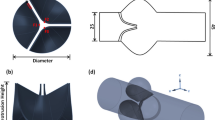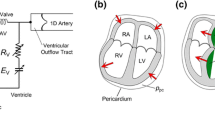Fluid flow in a transparent hydraulic test system was visualized. The test system was used to simulate the flow created by the Sputnik LVAD pump operating in the nominal mode (4.5 L/min) and at low (3 L/min) and high (6 L/min) rates. The study showed that the fluid flow velocity field in the pump was relatively stable in the diffuser zone. Increases in rotation speed led to a decrease in overall perturbation of the flow field. These results can be used to optimize the operation of the pump.
Similar content being viewed by others
References
Gautier, S. V., Shevchenko, A. O., Itkin, G. P., Zakharevich, V. M., Poptsov, V. N., Drobyshev, A. A., and Telyshev, D. V., “Artificial heart in Russia: Past, present, and future,” Artif. Org., 45, 111–114 (2021).
Saeed, O. and Jorde, U. P., “Advances in continuous flow left ventricular assist device support for end-stage heart failure: A therapy in evolution,” Cardiol. Rev., 25, No. 2, 84–88 (2017).
Petukhov, D., Korn, L., Walter, M., and Telyshev, D., “A novel control method for rotary blood pumps as left ventricular assist device utilizing aortic valve state detection,” BioMed. Res. Int., 2019, Article ID 1732160 (2019).
Su, B., Chua, L. P., and Wang, X., “Validation of an axial flow blood pump: Computational fluid dynamics results using particle image velocimetry,” Artif. Org., 36, No. 4, 359–367 (2012).
Xiao, Z., Tan, J., Wang, S., Yu, Z., and Wu, W., “PIV experimental study on the flow field characteristics of axial flow blood pump under three operating conditions,” J. Eng., 2019, No. 13, 155–158 (2019).
Yang, F., Kormos, R. L., and Antaki, J. F., “High-speed visualization of disturbed pathlines in axial flow ventricular assist device under pulsatile conditions,” J. Thor. Cardiovasc. Surg., 150, 938–944 (2015).
Porfiryev, A., Markov, A., Galyastov, A., Denisov, M., Burdukova, O., Gerasimenko, A. Y., and Telyshev, D., “Fontan hemodynamics investigation via modeling and experimental characterization of idealized pediatric total cavopulmonary connection,” Appl. Sci., 10, No. 19 (2020).
Chopski, S. G., Downs, E., Haggerty, C. M., Yoganathan, A. P., and Throckmorton, A. L., “Laser flow measurements in an idealized total cavopulmonary connection with mechanical circulatory assistance,” Artif. Org., 35, 1052–1064 (2011).
Telyshev, D., Denisov, M., Markov, A., Fresiello, L., Verbelen, T., and Selishchev, S., “Energetics of blood flow in Fontan circulation under VAD support,” Artif. Org., 44, 50–57 (2020).
Petukhov, D. S. and Telyshev, D. V., “Simulation of blood flow dynamics changes through implantable axial flow pump,” Biomed. Eng., 48, No. 6, 336–340 (2015).
Pugovkin, A. A., Markov, A. G., Selishchev, S. V., Korn, L., Walter, M., Leonhardt, S., Bockeria, L. A., Bockeria, O. L., and Telyshev, D. V., “Advances in hemodynamic analysis in cardiovascular diseases investigation of energetic characteristics of adult and pediatric Sputnik left ventricular assist devices during mock circulation support,” Cardiol. Res. Pract., 2019, Article ID 4593174 (2019).
Morales, D. L., Dibardino, D. J., McKenzie, E. D., Heinle, J. S., Chang, A. C., Loebe, M., Noon, G. P., Debakey, M. E., and Fraser, C. D., Jr., “Lessons learned from the first application of the DeBakey VAD Child: An intracorporeal ventricular assist device for children,” J. Heart Lung Transplant., 24, No. 3, 331–337 (2005).
Thielicke, W., and Stamhuis, E. J., “PIVlab – towards user-friendly, affordable and accurate digital particle image velocimetry in MATLAB,” J. Open Res. Softw., 2, No. 1 (2014).
Galyastov, A., Denisov, M., and Telyshev, D., Study of the Velocity Field in the Sputnik LVAD. Experimental Data [online resource]; https://www.researchgate.net/publication/351870389_Study_of_the_velocity_field_in_the_Sputnik_LVAD_Experimental_data.
Gregoric, I. D., “Mechanical circulatory support in acute heart failure,” Tex. Heart Inst. J., 39, No. 6, 854–855 (2012).
Slaughter, M. S., Pagani, F. D., Rogers, J. G., Miller, L. W., Sun, B., Russell, S. D., et al, “Clinical management of continuous-flow left ventricular assist devices in advanced heart failure,” J. Heart Lung Transplant., 29, No. 4, 1–39 (2010).
Kirklin, J. K., Naftel, D. C., Kormos, R. L., Stevenson, L. W., Pagani, F. D., Miller, M. A., et al, “Fifth INTERMACS annual report: Risk factor analysis from more than 6, 000 mechanical circulatory support patients,” J. Heart Lung Transplant., 32, No. 2, 141–156 (2013).
Author information
Authors and Affiliations
Corresponding author
Additional information
Translated from Meditsinskaya Tekhnika, Vol. 55, No. 4, Jul.-Aug., 2021, pp. 37-41.
Rights and permissions
About this article
Cite this article
Galiastov, A.A., Denisov, M.V., Groth, T. et al. A Study of the Velocity Field in the Sputnik Left Ventricular Assist Device. Biomed Eng 55, 278–283 (2021). https://doi.org/10.1007/s10527-021-10118-7
Received:
Published:
Issue Date:
DOI: https://doi.org/10.1007/s10527-021-10118-7




